- Published on
Analysis Report of the IT Job Market in Perth
Introduction
The Perth IT job market offers diverse opportunities for professionals in various technical and business-oriented roles. This report is based on a dataset of IT job listings from Seek, collected using SeekSpider (https://fudongs.com/blog/project/SeekSpider). The dataset contains a total of 550 rows, providing a comprehensive view of the available job positions, their requirements, and salary ranges.
The primary objective of this analysis is to assist job seekers in identifying high-demand roles, understanding employer preferences, and setting realistic salary expectations. Additionally, the report offers strategic recommendations to enhance job search effectiveness and career planning. Whether you are an entry-level candidate or an experienced professional, this analysis will equip you with the knowledge to navigate the competitive Perth IT job market successfully.
The subsequent sections detail the findings from the data analysis, including visual representations of key metrics such as job types, work types, job locations, skill requirements, and salary distributions. These insights will help job seekers make informed decisions and tailor their job search strategies to align with market demands and opportunities.
The first 5 rows of the original jobs data
| job_id | job_title | business_name | work_type | job_type | job_description | pay_range | suburb | area | url | advertiser_id |
|---|---|---|---|---|---|---|---|---|---|---|
| 74951950 | National Systems/Projects Accountant | Medlog Australia Pty Ltd | Full time | Networks & Systems Administration | MEDLOG is a global logistics and supply chain operator, spec | Fremantle, Perth WA | Fremantle & Southern Suburbs | https://www.seek.com.au/job/74951950 | 39994103 | |
| 74957865 | Junior/Graduate Front End Web Developer (React) | CTL Australia | Full time | Developers/Programmers | Job Description: As a Junior/Graduate Front End Web Develope | $60,000 - $80,000 per year annual bonus available | Perth WA | CBD, Inner & Western Suburbs | https://www.seek.com.au/job/74957865 | 44080520 |
| 74920023 | Network Systems Administrator | Town of Claremont | Full time | Networks & Systems Administration Government - Local (Government & Defence) | The Town of Claremont is a progressive local government that | $86,763.44 per year, plus up to 14% superannuation | Claremont, Perth WA | CBD, Inner & Western Suburbs | https://www.seek.com.au/job/74920023 | 26392680 |
| 74984274 | Business Systems Support Officer | Department of Justice | Full time | Business/Systems Analysts Government - State (Government & Defence) | Advance your career by joining one of the most diverse publi | $96,307 - $105,254 p.a. plus 11% Superannuation | Perth WA | CBD, Inner & Western Suburbs | https://www.seek.com.au/job/74984274 | 37739915 |
| 74990985 | System Asset Manager | Department of Defence | Full time | Networks & Systems Administration Government - Federal (Government & Defence) | The Role As the Auxiliaries Systems Asset Manager, you will | $91,702 - $104,753 (APS 6) + Super | Rockingham, Perth WA | Rockingham & Kwinana | https://www.seek.com.au/job/74990985 | 3561584 |
Common Job Types
Top 10 Job Types:
- Help Desk & IT Support: 101 jobs
- Business/Systems Analysts: 50 jobs
- Developers/Programmers: 46 jobs
- Programme & Project Management: 45 jobs
- Networks & Systems Administration: 39 jobs
- Engineering - Software: 37 jobs
- Architects: 26 jobs
- Security: 23 jobs
- Telecommunications: 23 jobs
- Other: 19 jobs
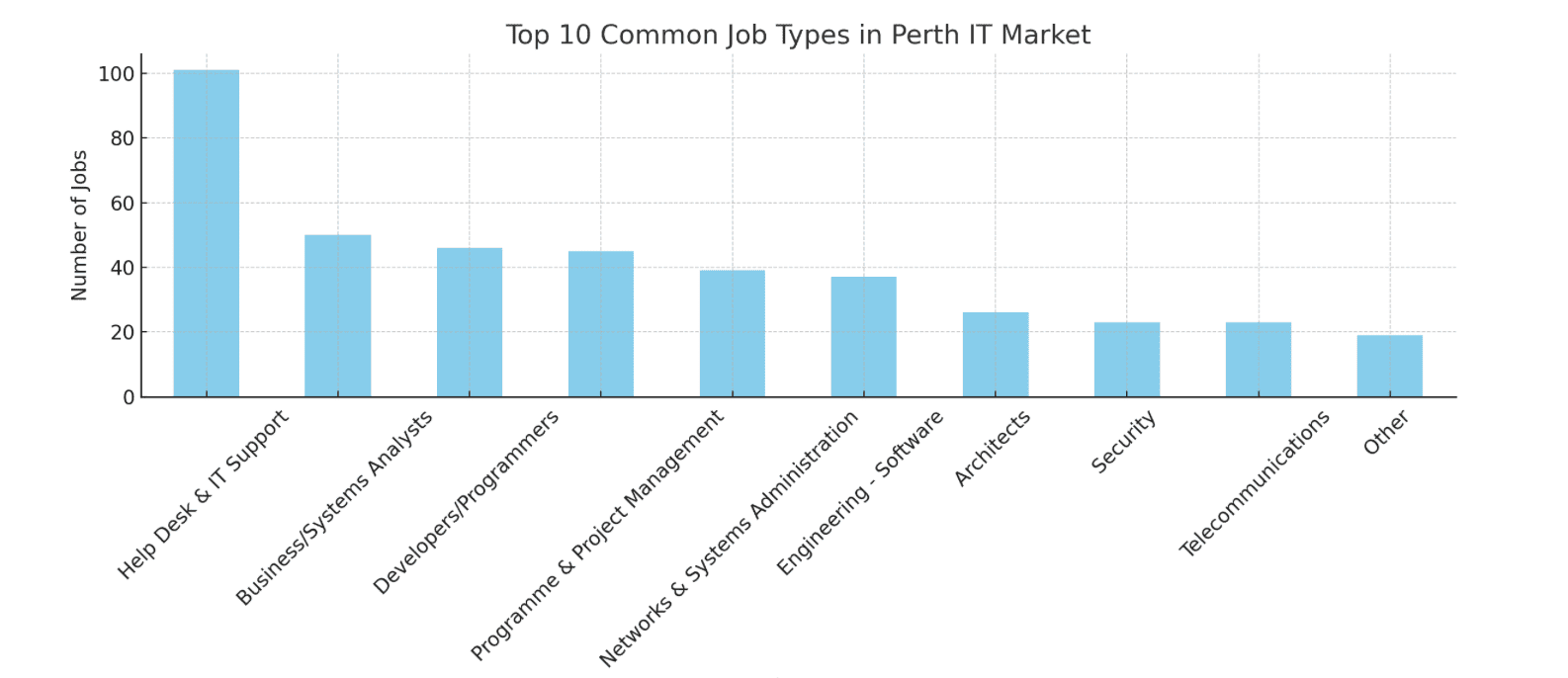
Analysis: The most common job type is in Help Desk & IT Support, indicating a high demand for roles focused on user and system support. Business/Systems Analysts and Developers/Programmers also have a significant presence, reflecting the need for both technical development and business-oriented IT roles.
import matplotlib.pyplot as plt
plt.figure(figsize=(12, 6))
common_job_types.plot(kind='bar', color='skyblue')
plt.title('Top 10 Common Job Types in Perth IT Market')
plt.xlabel('Job Type')
plt.ylabel('Number of Jobs')
plt.xticks(rotation=45)
plt.grid(True)
plt.tight_layout()
plt.savefig('/mnt/data/common_job_types.png')
Work Type Distribution
Work Types:
- Full time: 404 jobs (78.8%)
- Contract/Temp: 133 jobs (20.9%)
- Casual/Vacation: 11 jobs (0.2%)
- Part time: 2 jobs (0.1%)
Analysis: Full-time positions dominate the job market, suggesting stability and long-term employment opportunities are preferred by employers. Contract and temporary positions also hold a considerable share, offering flexibility for both employers and employees.
Common Job Locations
Top 10 Areas:
- CBD, Inner & Western Suburbs: 407 jobs
- Fremantle & Southern Suburbs: 49 jobs
- Northern Suburbs & Joondalup: 41 jobs
- Eastern Suburbs: 30 jobs
- Perth: 20 jobs
- Rockingham & Kwinana: 3 jobs
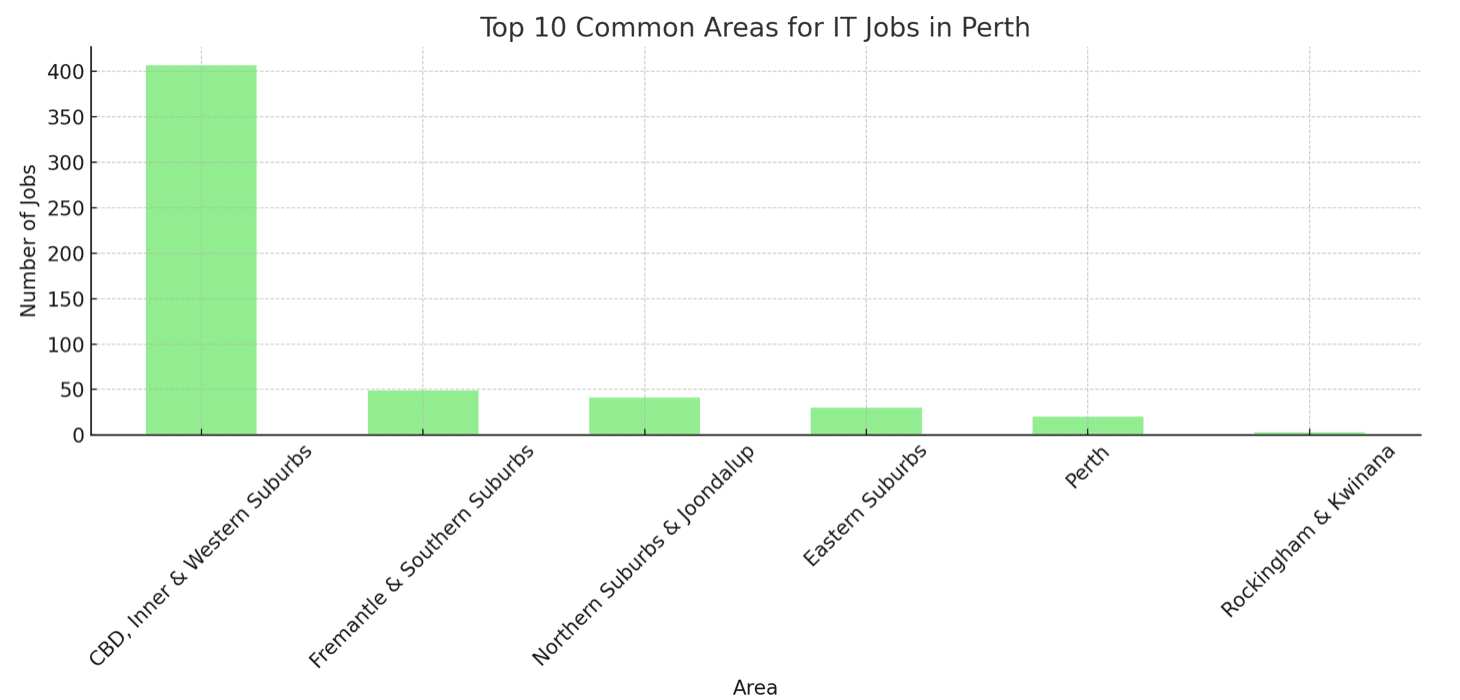
# Plot common areas
plt.figure(figsize=(12, 6))
common_areas.plot(kind='bar', color='lightgreen')
plt.title('Top 10 Common Areas for IT Jobs in Perth')
plt.xlabel('Area')
plt.ylabel('Number of Jobs')
plt.xticks(rotation=45)
plt.grid(True)
plt.tight_layout()
plt.savefig('/mnt/data/common_areas.png')
Analysis: The majority of IT jobs are concentrated in the CBD, Inner & Western Suburbs. This centralization suggests that job seekers targeting these areas may find more opportunities and possibly higher competition.
Most Frequently Mentioned Skills
Top 20 Skills:
- Experience: 1965 mentions
- Team: 1504 mentions
- Work: 1486 mentions
- Role: 1291 mentions
- Support: 1274 mentions
- Business: 1192 mentions
- Skills: 1132 mentions
- Management: 897 mentions
- Working: 873 mentions
- Project: 785 mentions
- Development: 772 mentions
- Apply: 747 mentions
- Service: 734 mentions
- People: 713 mentions
- Solutions: 707 mentions
- Technical: 699 mentions
- Data: 695 mentions
- Services: 691 mentions
- Systems: 679 mentions
from wordcloud import WordCloud
# Create a word cloud of the most frequently mentioned skills/technologies
skills_text = ' '.join(filtered_jobs_with_salaries['job_description'].dropna().values)
# Generate word cloud
wordcloud = WordCloud(width=800, height=400, background_color='white', collocations=False).generate(skills_text)
# Display the word cloud
plt.figure(figsize=(10, 6))
plt.imshow(wordcloud, interpolation='bilinear')
plt.axis('off')
plt.title('Most Frequently Mentioned Skills and Technologies')
plt.tight_layout()
plt.savefig('/mnt/data/skills_wordcloud.png')
# Plot most frequently mentioned skills
common_skills_labels, common_skills_values = zip(*common_skills)
plt.figure(figsize=(14, 6))
plt.barh(common_skills_labels, common_skills_values, color='lightcoral')
plt.title('Top 20 Most Frequently Mentioned Skills in Job Descriptions')
plt.xlabel('Frequency')
plt.grid(True)
plt.tight_layout()
plt.savefig('/mnt/data/common_skills.png')
Key Observations:
- Experience: Emphasized heavily, indicating that prior relevant experience is highly valued by employers.
- Team: Collaborative skills and the ability to work effectively in teams are crucial.
- Support: Technical support skills are in demand, reflecting the need for roles that assist users and maintain systems.
- Business: Understanding business needs and integrating IT solutions to meet these needs is important.
- Management: Project management and people management skills are frequently mentioned, indicating the importance of leadership and organizational abilities.
- Technical Skills: Specific technical skills related to project development, data handling, and system management are valued.
Detailed Analysis
From the analysis of job descriptions and the word cloud, it is clear that the following skills and technologies are most sought after in the Perth IT job market:
- Experience: Employers prioritize candidates with proven track records in their respective fields.
- Team Collaboration: Being able to work well in a team environment is crucial.
- Technical Support: Skills in providing technical assistance and maintaining IT systems are highly demanded.
- Business Acumen: Understanding the business context and being able to align IT solutions with business goals is important.
- Management: Both project and people management skills are valued, highlighting the need for leadership capabilities.
- Development and Data Skills: Proficiency in software development, data management, and systems administration is essential.
Recommendations for Job Seekers
- Highlight Relevant Experience: Ensure your resume and job applications emphasize relevant experience.
- Showcase Team Skills: Demonstrate your ability to work effectively in team settings.
- Focus on Support Roles: If you have technical support experience, highlight this in your applications.
- Develop Business Understanding: Gain knowledge in business processes and how IT solutions can support them.
- Enhance Management Skills: If applicable, highlight any management or leadership roles you have held.
- Technical Proficiency: Continuously improve your technical skills, particularly in software development and data management.
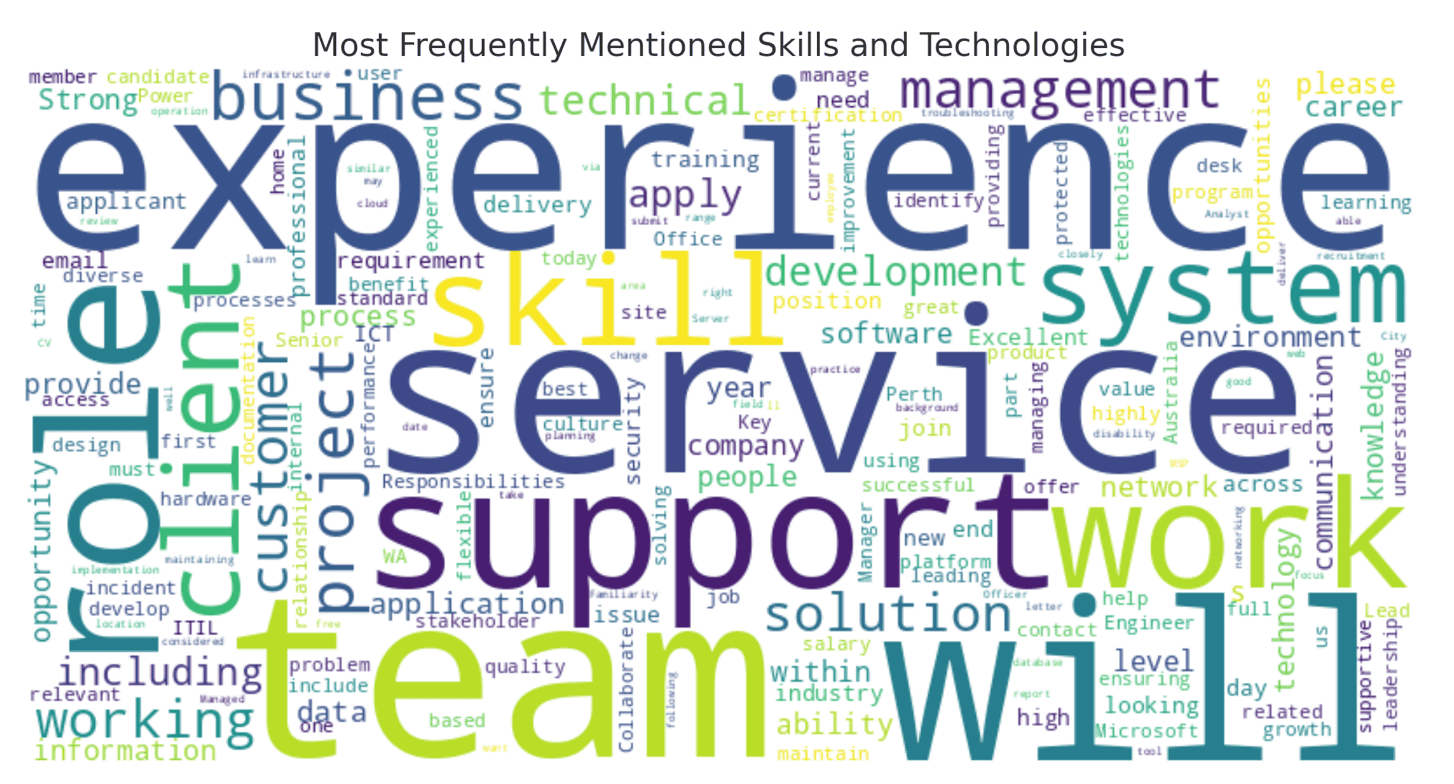
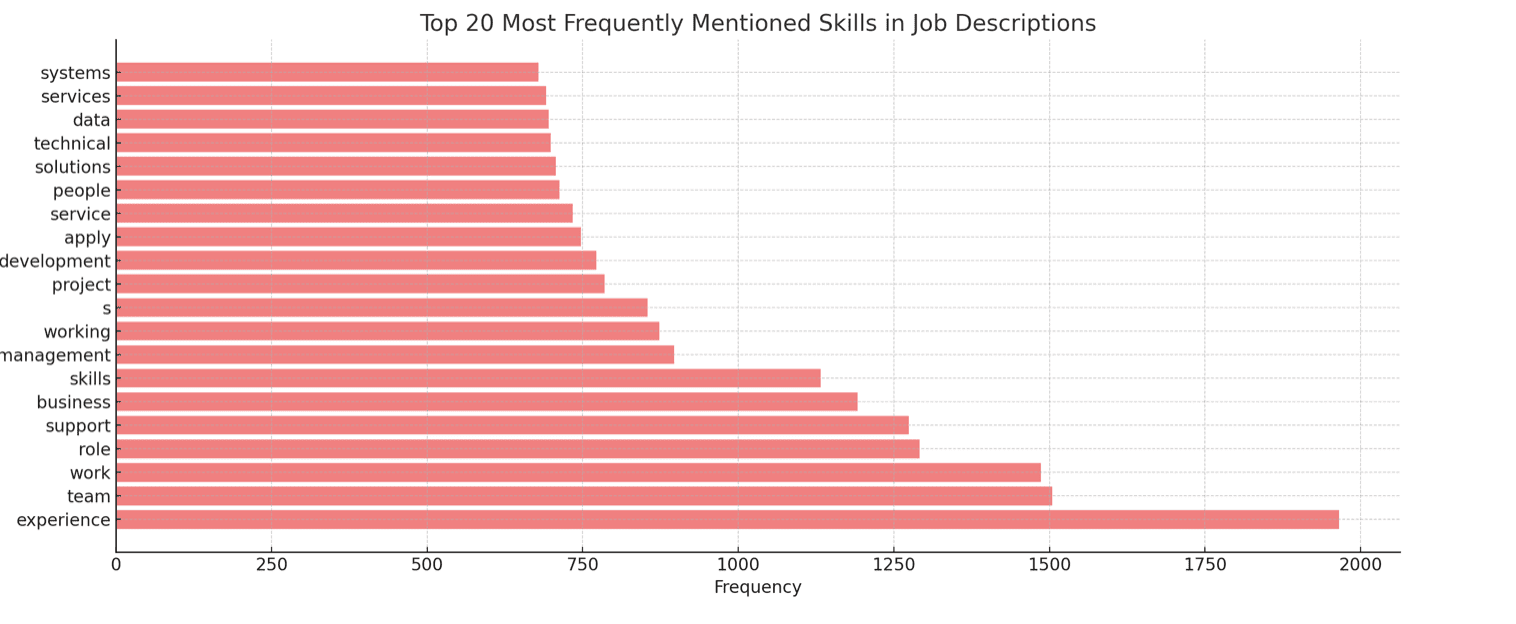
Analysis of Popular IT Technologies and Programming Languages
Based on the job descriptions, here are the most mentioned IT technologies and programming languages in the Perth IT job market:
Top IT Technologies and Programming Languages
- Cloud: 23 mentions
- Azure: 20 mentions
- SQL: 19 mentions
- React: 18 mentions
- AWS: 13 mentions
- Python: 9 mentions
- AI (Artificial Intelligence): 7 mentions
- PostgreSQL: 6 mentions
- JavaScript: 4 mentions
- Git: 4 mentions
- Node.js: 4 mentions
- Swift: 3 mentions
- DevOps: 3 mentions
- Backend: 3 mentions
- CSS: 3 mentions
- Go: 3 mentions
- HTML: 3 mentions
- Docker: 2 mentions
- PHP: 2 mentions
- Linux: 2 mentions
# Extract relevant parts of job descriptions to identify popular IT tech stacks and programming languages
tech_keywords = [
'python', 'java', 'javascript', 'react', 'angular', 'vue', 'c#', 'c++', 'sql', 'html', 'css', 'aws', 'azure',
'docker', 'kubernetes', 'node', 'typescript', 'php', 'ruby', 'go', 'swift', 'scala', 'perl', 'linux', 'unix',
'git', 'mysql', 'postgresql', 'mongodb', 'nosql', 'tensorflow', 'pytorch', 'machine learning', 'ai', 'cloud',
'devops', 'blockchain', 'big data', 'data science', 'hadoop', 'spark'
]
# initialize the counter for the updated keywords
tech_counter = Counter()
# Tokenize the job descriptions and count the occurrences of each keyword
for desc in filtered_jobs_with_salaries['job_description'].dropna().values:
words = re.findall(r'\b\w+\b', desc.lower())
for word in words:
if word in tech_keywords:
tech_counter[word] += 1
# Convert the counter to a DataFrame for better visualization
tech_df = pd.DataFrame.from_dict(tech_counter, orient='index', columns=['count']).sort_values(by='count', ascending=False)
import ace_tools as tools; tools.display_dataframe_to_user(name="Popular IT Technologies and Programming Languages", dataframe=tech_df)
tech_df.head(20)
# Plot the top 20 IT technologies and programming languages
top_20_tech = tech_df.head(20)
# Plot the bar chart for the top 20 IT technologies and programming languages
plt.figure(figsize=(14, 8))
top_20_tech.plot(kind='bar', color='skyblue', legend=False)
plt.title('Top 20 Most Mentioned IT Technologies and Programming Languages')
plt.xlabel('Technologies and Programming Languages')
plt.ylabel('Frequency')
plt.xticks(rotation=45)
plt.grid(True)
plt.tight_layout()
plt.savefig('/mnt/data/top_20_tech_languages.png')
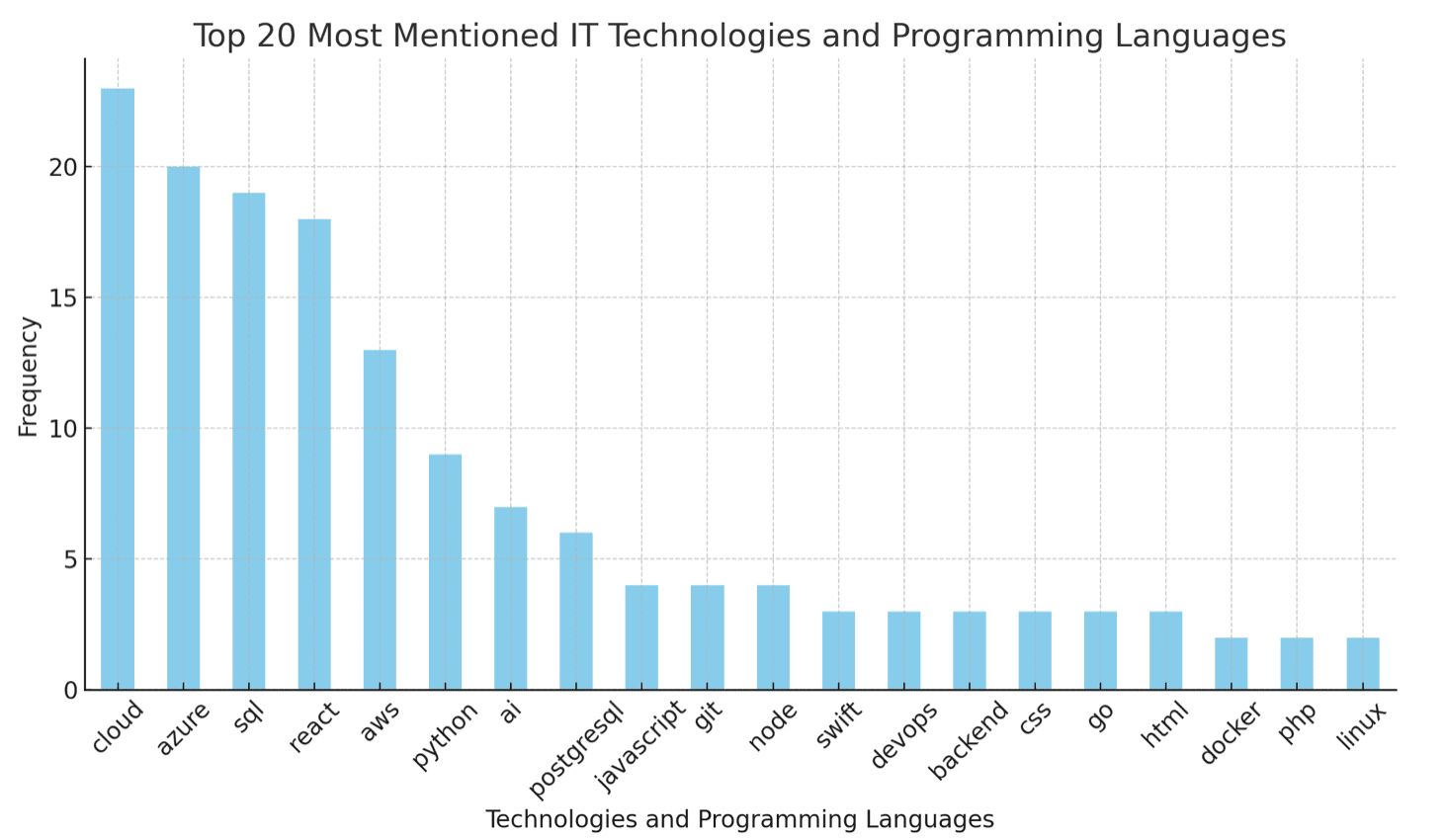
Detailed Analysis
The analysis reveals that the most popular technologies and languages are closely related to cloud computing, web development, databases, and modern software engineering practices. Here are some key insights:
- Cloud Technologies: Cloud-related skills are highly sought after, with Azure and AWS leading the way. This suggests a strong demand for cloud infrastructure and services expertise.
- Web Development: React is the most mentioned front-end framework, indicating its popularity among employers for building user interfaces. HTML, CSS, and JavaScript are foundational skills required for web development.
- Databases: SQL and PostgreSQL are the most mentioned database technologies, reflecting the need for data management and manipulation skills.
- Programming Languages: Python is highly valued, especially for its versatility in web development, data science, and AI. JavaScript is essential for front-end development.
- DevOps and Tools: DevOps practices and tools like Docker, Git, and backend technologies are also in demand, highlighting the importance of continuous integration and deployment skills.
Recommendations for Job Seekers
- Focus on Cloud Skills: Enhance your expertise in cloud technologies like Azure and AWS to meet the high demand in this area.
- Master Web Development: Develop strong skills in React, HTML, CSS, and JavaScript to increase your appeal for front-end development roles.
- Learn Databases: Gain proficiency in SQL and PostgreSQL to handle data effectively, as database skills are crucial.
- Embrace Modern Programming: Strengthen your knowledge of Python and JavaScript, which are widely used and versatile programming languages.
- Adopt DevOps Practices: Familiarize yourself with DevOps tools and practices to improve your chances in roles that require continuous integration and deployment capabilities.
Salary Analysis and Distribution
Salary Statistics
- Count: 70 valid salary entries
- Mean (Average) Salary: $115,029.40
- Standard Deviation: $181,649.30
- Minimum Salary: $50,000.55
- 25th Percentile: $72,476.62
- Median (50th Percentile) Salary: $85,000.00
- 75th Percentile: $114,375.00
- Maximum Salary: $1,595,000.00
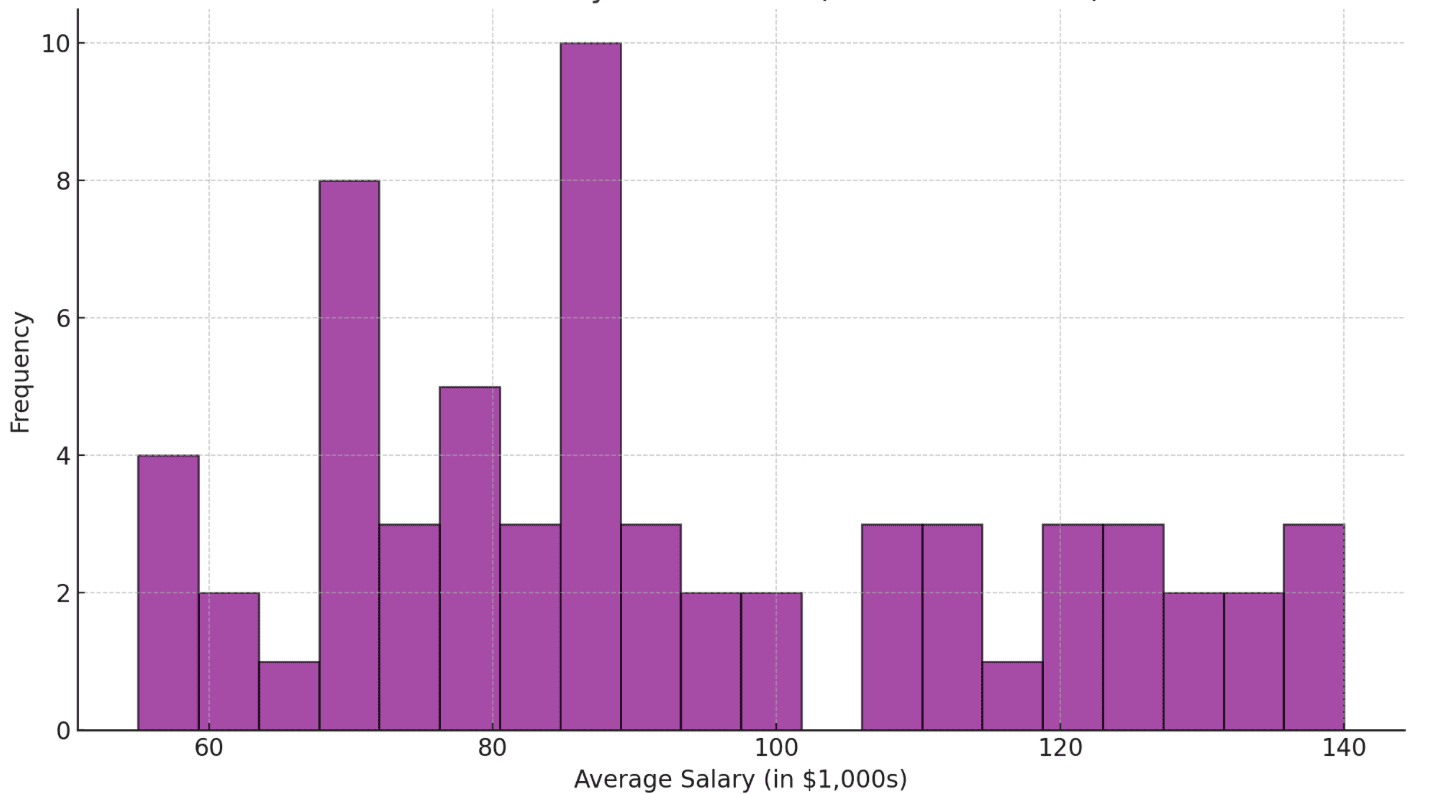
# Remove outliers by filtering salaries between the 5th and 95th percentiles
lower_bound = filtered_jobs_with_salaries['avg_salary_k'].quantile(0.05)
upper_bound = filtered_jobs_with_salaries['avg_salary_k'].quantile(0.95)
filtered_salaries_no_outliers = filtered_jobs_with_salaries[(filtered_jobs_with_salaries['avg_salary_k'] >= lower_bound) & (filtered_jobs_with_salaries['avg_salary_k'] <= upper_bound)]
# Plot the filtered salary distribution without outliers
plt.figure(figsize=(10, 6))
plt.hist(filtered_salaries_no_outliers['avg_salary_k'], bins=20, edgecolor='k', alpha=0.7, color='purple')
plt.title('Filtered Salary Distribution (Without Outliers)')
plt.xlabel('Average Salary (in $1,000s)')
plt.ylabel('Frequency')
plt.grid(True)
plt.tight_layout()
plt.savefig('/mnt/data/filtered_salary_distribution_no_outliers.png')
Salary Distribution
Analysis: By excluding salaries below $50,000, the average salary significantly increases, indicating that most IT positions offering substantial salaries are in higher demand. The high standard deviation persists, showcasing variability among senior roles and specific high-paying positions.
Key Observations:
- Higher Mean Salary: The mean salary is now $115,029.40, which is more reflective of mid to senior-level IT positions.
- Reasonable Range: The salary range is more reasonable for professional IT roles, with the 25th percentile starting at $72,476.62 and the 75th percentile at $114,375.00.
- High-Paying Outliers: There are still some very high-paying positions, indicating opportunities for highly experienced and specialized professionals.
Recommendations for Job Seekers
- Target Higher Salary Roles: Job seekers with relevant experience should aim for positions that offer salaries above $50,000. Highlighting specialized skills and experience can help secure these higher-paying roles.
- Negotiate Salaries: Understanding the typical salary ranges can aid in better salary negotiations. Candidates should be prepared to justify their salary expectations based on their skills and market data.
- Consider Senior Roles: Experienced professionals should look for senior roles or specialized positions, which are more likely to offer competitive salaries.
Conclusions and Recommendations
The Perth IT job market is robust, with high demand for roles in IT support, business analysis, and programming. Key skills include cloud technologies (Azure, AWS), web development (React, HTML, CSS, JavaScript), and databases (SQL, PostgreSQL). Job seekers should focus on gaining relevant experience, developing these in-demand technical skills, and preparing for full-time roles to align with market trends and increase their employment prospects.